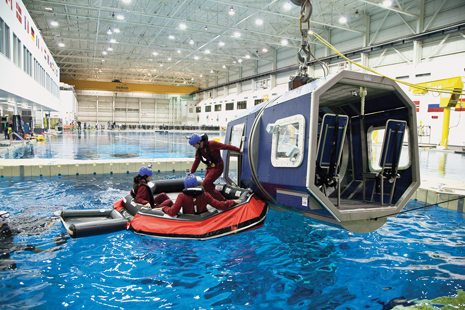|
The image of astronauts and offshore oil workers in the same, super-sized water tank seems like it could be the plot of a futuristic sci-fi movie. The idea, however, is real and the ‘movie set’ is the most sophisticated and technologically-advanced underwater training center in the world —U.S. National Aeronautics and Space Administration’s (NASA) Johnson Space Center (JSC) underwater facility in Houston, Texas. Now, for the first time in history, NASA has partnered with Raytheon Technical Services and Petrofac Training Services, to provide offshore safety training programs to the oil and gas industry, bringing together two industries—a world apart—to make one giant splash for all mission-critical operations worldwide.
 |
Offshore oil & gas workers participate in Hi-Con Survival Training.
Photo courtesy of Felix Sanchez
|
|
The JSC’s Neutral Buoyancy Lab (NBL), completed in 1995, was originally designed with a 40-ft-deep, 6.2-million-gal pool and life-size mock-up of the International Space Station to train astronauts for space missions. It is the largest indoor pool in the world, and Raytheon began managing the NBL facility in 2003. Last year, NASA gave Raytheon permission to use the facility for nongovernmental purposes.
“Since the Macondo incident, a number of new government regulations have been issued, and the industry has responded by working in partnership with the government to find ways to make this high-risk environment a safer place for all,” said Tony Littler, Petrofac’s regional director, America. “There is a real willingness to change in the sector, and we are all working in partnership to make this a reality.”
In November, Petrofac partnered with Raytheon and NASA, and announced a series of comprehensive offshore training courses, including Basic Offshore Safety Induction and Emergency Training and Further Offshore Emergency Training courses. Helicopter Underwater Egress Training simulators and life raft will be employed to create the immersive and realistic training situations, plus fire, ground and marine facilities to bring OPITO (Offshore Petroleum Industry Training Organization) accreditation to the courses. “Together, Raytheon and Petrofac will offer similar training solutions to oil and gas industry customers, who also require a focus on safe operations and mission assurance,” said Raytheon President for Technical Services John Harris II. The team also plans to introduce Emergency Response & Crisis Management training.
While the NBL will still be used for NASA mission-critical space training, the partners plan to install a transparent, 12-ft grated floor into designated areas of the 202-by-102-ft pool to accommodate the new offshore offerings.
“The facility has a host of sophisticated equipment, including high-definition underwater audio and video capability; fully supported dive equipment; onsite design; engineering and fabrication facilities to allow for offshore mock-ups to be created; and state-of-the-art control rooms to simulate offshore emergencies,” said Littler.
Aside from expanding utilization of the facility for training, the oil and gas industry is looking to share ideas with NASA on improving offshore safety. “Through this partnership, we will be able to learn from, and draw upon, the combined safety cultures, knowledge and expertise from within the aerospace and oil and gas industries,” Littler said. “This linkage between manned space flight, and the oil and gas industry, has an exciting future.”
Through the partnership, the aerospace community hopes to gain some insight from the oil and gas industry on improving its space operations. “By opening Johnson Space Center’s facilities and resources for use by non-aerospace industries, NASA hopes to find areas of common interest, where both parties can help each other foster new technologies that not only improve life here on Earth, but also pave the way for future human exploration in space,” NASA said. 
|



